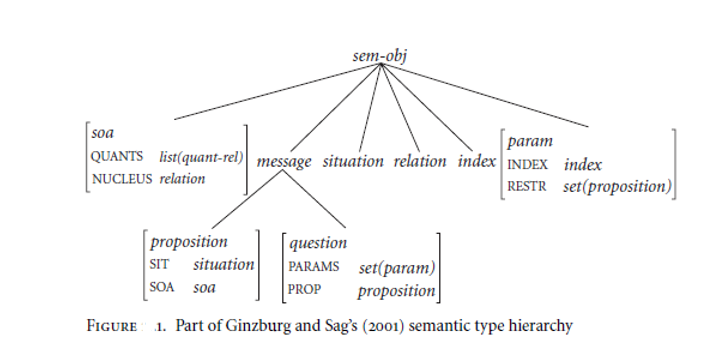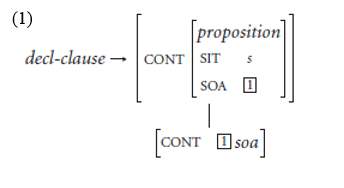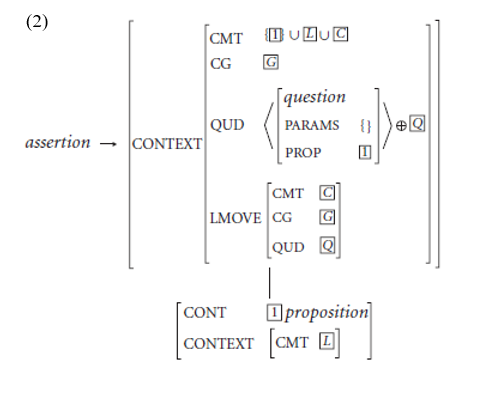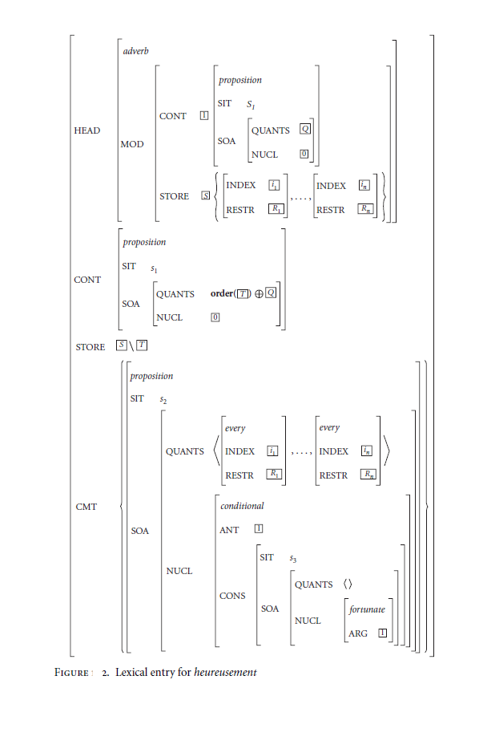


 Grammar
Grammar
 Tenses
Tenses
 Present
Present
 Past
Past
 Future
Future
 Parts Of Speech
Parts Of Speech
 Nouns
Nouns
 Verbs
Verbs
 Adverbs
Adverbs
 Adjectives
Adjectives
 Pronouns
Pronouns
 Pre Position
Pre Position
 Preposition by function
Preposition by function 
 Preposition by construction
Preposition by construction
 Conjunctions
Conjunctions
 Interjections
Interjections
 Grammar Rules
Grammar Rules
 Linguistics
Linguistics
 Semantics
Semantics
 Pragmatics
Pragmatics
 Reading Comprehension
Reading Comprehension
 Teaching Methods
Teaching Methods|
Read More
Date: 2024-01-25
Date: 8-3-2022
Date: 2024-01-15
|
The fragment of grammar
In this section we provide an HPSG grammar fragment accounting for the syntax and semantics of clause-initial evaluatives in declaratives. We adopt the framework of Ginzburg and Sag (2001), which is characterized by three notable features. First, clause types are intimately connected to a (situationtheoretic) abstract object ontology which distinguishes, among other things, states of affairs (soa), propositions, and questions. A basic proposition is structurally determined by a situation s and a state of affairs Û, and says that Û holds in s . Propositions serve as the denotation of declarative clauses. Questions are analyzed as n-ary abstractions over propositions, where the abstraction operation applies to sets of parameters; the ontology is set up in such a way that a 0-ary abstract is an object distinct from the proposition it abstracts over, and 0-ary abstracts serve as the denotation of polar interrogatives. In the HPSG grammar, each semantic object type is associated with a feature structure specifying the structural parts of this object, as illustrated by the type hierarchy in Fig.1. An soa is structurally determined by an elementary predication, its nucleus, and a list of (scoped) quantifiers; a proposition is determined by a situation and an soa; and a question is determined by a set of parameters (technically, variables associated with a set of restrictions) and a proposition. The types proposition and question have a common supertype message, which encodes the intuition that these semantic objects serve as content for full clauses.

Second, since clause-internal semantic composition relies on soas, some kind of type-shifting is necessary to construct propositions and questions. Here we assume that this is effected by special unary syntactic rules,1 such as the rule in (1) for declaratives.2

Finally, speech acts are directly represented in the grammar, at the level of complete utterances. Here we depart slightly from Ginzburg and Sag (2001) by representing directly the effect of the utterance on the dialogue gameboard, instead of positing an explicit illocutionary relation as the content of the utterance. (2), the constraint on utterances of type assertion, reiterates in the format of an HPSG grammar. The feature lmove (for latest-move) represents the state of the participant’s gameboard just before the current move, while unembedded cmt, cg, and qud features correspond to the state of the gameboard after the current move. The propositional content of the clause 1 gets added to the speaker’s commitment, and the corresponding polar question is added to the qud. In addition, we leave room for extra commitments L of the speaker to be introduced by the clause independently of the main propositional content 1 and of the commitments inherited from the lmove, C ; this will be crucial to the analysis of evaluatives.3

We are now in a position to make explicit the analysis of evaluative adverbs such as heureusement. Recall the three main points of our analysis: heureusement is a proposition operator; it makes no contribution to the semantic content; and it contributes a proposition to the speaker’s commitments. Let us show how these three points are encoded in heureusement’s lexical entry, which is shown in Fig. 2.
First Fig. 2 states that heureusement is an adverb, which may modify an expression whose content is of type proposition. In the version of HPSG assumed in this chapter, adjuncts get combined with heads via the hd-adjph phrase type, which states that the adjunct’s mod value is identified with the head’s synsem. Thus Fig. 2 states that heureusement is an adverb which combines with a proposition-denoting phrase. The proposition may be an open proposition, in which case the phrase has binders for free parameters in store. In the setup of Ginzburg and Sag (2001), store is a Cooper-style storage mechanism that includes both unscoped quantifiers and the parameter associated with wh-interrogative phrases.

Second, we want to account for the intuition that the adverb makes no contribution to the main semantic content. Intuitively, this could be encoded by identifying the adverb’s cont with the cont of the modified head. However, given the way the store mechanism works in Ginzburg and Sag’s framework, we must leave room for quantifiers to scope at the adverb node, because this might be the only place where they can scope. Thus we only identify the nucleus of the adverb with that of the modified head, and allow for some quantifiers T to be taken out of store and scoped (order( T )) at the adverb node.4 The non-deterministic function order outputs an ordered sequence of quantifiers, and thus fixes the relative scope of the members of T .
Third, the evaluative adverb makes its semantic contribution as part of the Speaker’s cmt list. The proposition in cmt is a feature-structural rendering of the semantic analysis. Note that all free variables in the argument of the adverb end up being universally quantified, as needed; the workings of the store mechanism ensure that appropriate restrictors are retrieved for the universal quantifiers.
We now illustrate the analysis with a few examples. Let us first assume that the modified phrase’s store value is empty; the quants list of the speaker’s commitment is also empty,5 and so is T , the set of quantifiers scoped at the level of the adverb. As a result, the adverb’s content, which is identified with that of the whole phrase, is identical to that of the head. But a new proposition is put in the set of speaker commitments, corresponding to the meaning of the evaluative. Fig. 3 makes explicit the analysis of a simple example. For readability semantic objects have been abbreviated. Note that the evaluative can only combine once the type-shifting decl-clause unary phrase has applied, because this is the only way for it to find a proposition argument.
We now turn to cases where the store value of the modified phrase is not empty. Sentence (3) has two readings, depending on whether heureusement takes the quantifier in its scope.6

In Ginzburg and Sag’s (2001) setup, quantifiers are scoped at lexical nodes. The first reading is obtained when the quantifier is scoped at the V level. Thus the store of the verb is empty, and heureusement inherits an empty store. The final analysis is as in Fig. 4.
In the other reading, represented in Fig. 5, the quantifier is not scoped at the level of the verb. Accordingly, the store is non-empty as it reaches the adverb. Let us assume that the quantifier is scoped at the level of the adverb, which is the only remaining possibility in this particular example; that is, the store of the verb is a singleton containing most students, and this singleton ( T in Fig. 2) is scoped at the level of the adverb which thus has an empty store. The interesting point here is that since the modified phrase’s store is non-empty, universal closure comes into play at the level of the ancillary commitment: as stated in Fig. 2, a universal quantifier is scoped which takes over the index and restriction of the unscoped quantifier. As a result we get the correct reading corresponding to (3b).7
1 Ginzburg and Sag (2001) avoid positing unary rules for declaratives by incorporating type shifting in head–subject combinations. However this won’t do for French, where declarative clauses can consist of a bare VP, when the subject is a pronominal clitic, which we analyze as a prefix on the verb (Miller 1992).
2 As is usual in HPSG depictions of feature structures as attribute–value matrices, boxed characters such as 1 are tags used to represent reentrancies in the feature structure; thus (1) indicates that the value of the path cont|soa on the mother is token-identical to the value of the path cont on the daughter. Numerical tags ( 1 , 2 , etc.) are used for plain objects, while alphabetical tags ( A , B , etc.) are used for lists and sets of objects.
3 We assume that cmt inheritance inside clauses works as for other contextual features. Ordinary words come with an empty cmt, although there are some exceptions, such as evaluative adverbs. The cmt of a phrase is the union of the cmt of its daughters. It is only at the level of the full utterance that the commitments inherited from the latest move get added to cmt.
4 “” denotes set subtraction, i.e. U = S T iff S = T ∪ U and U ∩ T = ∅.
5 The analysis as presented here is slightly simplified in that it does not allow quantifiers stemming from the evaluative phrase itself, as in heureusement pour tout le monde ‘fortunately for everybody.’ See Bonami and Godard (2007b) for a more complete treatment of the syntax–semantics interface.
6 The second reading is more natural when the adverb is after the verb, and may not be available at all for some speakers, as in many other cases of wide scope proportional quantifiers.
7 Note that the use of the same store mechanism for wh-phrase content entails that, when extended to interrogatives, the current treatment will solve the problem noted in footnote 8. In the implementation of universal closure encoded in Fig. 2, the restrictions on unscoped indexes R1 ,. . . , Rn are taken over as restrictions of the universal quantifiers. This is true both for indexes corresponding to unscoped quantifiers and for indexes corresponding to unscoped wh-phrases.
|
|
|
|
حقن الذهب في العين.. تقنية جديدة للحفاظ على البصر ؟!
|
|
|
|
|
|
|
علي بابا تطلق نماذج "Qwen" الجديدة في أحدث اختراق صيني لمجال الذكاء الاصطناعي مفتوح المصدر
|
|
|
|
|
|
|
مشاتل الكفيل تنتج أنواعًا مختلفة من النباتات المحلية والمستوردة وتواصل دعمها للمجتمع
|
|
|